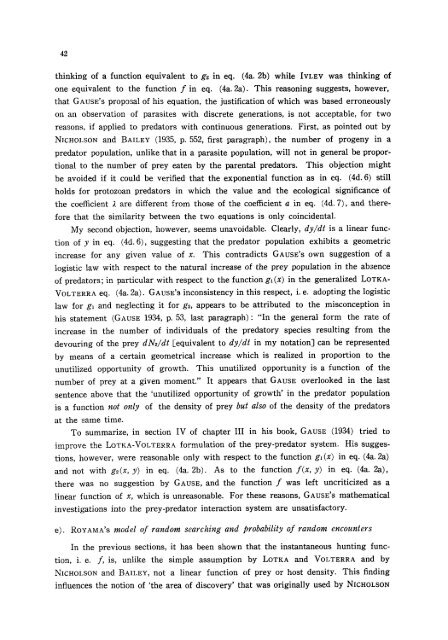A comparative study of models for predation and parasitism
A comparative study of models for predation and parasitism
A comparative study of models for predation and parasitism
You also want an ePaper? Increase the reach of your titles
YUMPU automatically turns print PDFs into web optimized ePapers that Google loves.
42<br />
thinking <strong>of</strong> a function equivalent to g2 in eq. (4a. 2b) while IVLEV was thinking <strong>of</strong><br />
one equivalent to the function f in eq.<br />
(4a. 2a). This reasoning suggests, however,<br />
that GAUSE'S propgsal <strong>of</strong> his equation, the justification <strong>of</strong> which was based erroneously<br />
on an observation <strong>of</strong> parasites with discrete generations, is not acceptable, <strong>for</strong> two<br />
reasons, if applied to predators with continuous generations. First, as pointed out by<br />
NICHOLSON <strong>and</strong> BAILEY (1935, p. 552, first paragraph), the number <strong>of</strong> progeny in a<br />
predator population, unlike that in a parasite population, will not in general be propor-<br />
tional to the number <strong>of</strong> prey eaten by the parental predators.<br />
be avoided if it could be verified that the exponential function as in eq.<br />
This objection might<br />
(4d. 6) still<br />
holds <strong>for</strong> protozoan predators in which the value <strong>and</strong> the ecological significance <strong>of</strong><br />
the coefficient ~ are different from those <strong>of</strong> the coefficient a in eq. (4d. 7), <strong>and</strong> there-<br />
<strong>for</strong>e that the similarity between the two equations is only coincidental.<br />
My second objection, however, seems unavoidable. Clearly, dy/dt is a linear func-<br />
tion <strong>of</strong> y in eq. (4d. 6), suggesting that the predator population exhibits a geometric<br />
increase <strong>for</strong> any given value <strong>of</strong> x. This contradicts GAUSE'S own suggestion <strong>of</strong> a<br />
logistic law with respect to the natural increase <strong>of</strong> the prey population in the absence<br />
<strong>of</strong> predators; in particular with respect to the function gl (x) in the generalized LOTKA-<br />
VOLTERRA eq. (4a. 2a). GAUSE'S inconsistency in this respect, i.e. adopting the logistic<br />
law <strong>for</strong> gl <strong>and</strong> neglecting it <strong>for</strong> gz, appears to be attributed to the misconception in<br />
his statement (GAuSE 1934, p. 53, last paragraph): "In the general <strong>for</strong>m the rate <strong>of</strong><br />
increase in the number <strong>of</strong> individuals <strong>of</strong> the predatory species resulting from the<br />
devouring <strong>of</strong> the prey dN2/dt Eequivalent to dy/dt in my notation] can be represented<br />
by means <strong>of</strong> a certain geometrical increase which is realized in proportion to the<br />
unutilized opportunity <strong>of</strong> growth.<br />
This unutilized opportunity is a function <strong>of</strong> the<br />
number <strong>of</strong> prey at a given moment." It appears that GAUSE overlooked in the last<br />
sentence above that the 'unutilized opportunity <strong>of</strong> growth' in the predator population<br />
is a function not only <strong>of</strong> the density <strong>of</strong> prey but also <strong>of</strong> the density <strong>of</strong> the predators<br />
at the same time.<br />
To summarize, in section IV <strong>of</strong> chapter III in his book, GAUSE (1934) tried to<br />
improve the LOTKA-VOLTERRA <strong>for</strong>mulation <strong>of</strong> the prey-predator system. His sugges-<br />
tions, however, were reasonable only with respect to the function gl (x) in eq. (4a. 2a)<br />
<strong>and</strong> not with g2(x, y) in eq. (4a. 2b). As to the function f(x, y) in eq. (4a. 2a),<br />
there was no suggestion by GAUSE, <strong>and</strong> the function f was left uncriticized as a<br />
linear function <strong>of</strong> x, which is unreasonable. For these reasons, GAUSE'S mathematical<br />
investigations into the prey-predator interaction system are unsatisfactory.<br />
e). ROYAMA'S model <strong>of</strong> r<strong>and</strong>om searching <strong>and</strong> probability <strong>of</strong> r<strong>and</strong>om encounters<br />
In the previous sections, it has been shown that the instantaneous hunting func-<br />
tion, i. e. f, is, unlike the simple assumption by LOTKA <strong>and</strong> VOLTERRA <strong>and</strong> by<br />
NICHOLSON <strong>and</strong> BAILEY, not a linear function <strong>of</strong> prey or host density. This finding<br />
influences the notion <strong>of</strong> 'the area <strong>of</strong> discovery' that was originally used by NICHOLSON















